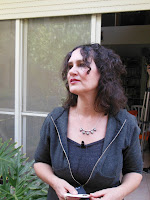 |
| Nomika Zion of Another Voice |
I know - I said that I wouldn’t be going anywhere near
Gaza. Well, I didn’t lie exactly – I just
didn’t know that part of our “mid-term training” would include a visit to Sderot
to meet an Israeli peace activist living in this “fortified” city, and the opportunity to see
for ourselves how ordinary people live under extraordinary circumstances.
Sderot is an Israeli community of about 25,000 people, located 2 miles from the border with Gaza. Nomika Zion, founder and spokesperson for Another Voice (http://www.othervoice.org/welcome-eng.htm), an Israeli organization that seeks to find a non-violent way to end the (Palestinian/Israeli) conflict, hosted our group in her home and gave us a tour of the city during the morning we spent there.
“In 1987, people were moving freely back and forth between
Gaza and Sderot,” Zion says. “There was
shopping, visits with friends and trips to the beach.” All that changed with in 2001, when rockets
started flying across the border from Gaza.
(In this post, I’ll
refrain from casting blame on who started this - or any! - conflict, or which
“side” suffered the most casualties.
This story is about how Sderot copes, and how a small group of Israeli
peace activists refuses to be intimidated by the violence they see around them.)
 |
| The caterpillar in the background is actually a shelter |
Sderot, Zion tells us, is “the most heavily fortified city
in the world.” The reasons for the
fortifications are obvious – when things “heat up” in the Gaza strip, as they
did most recently last November, Sderot and its citizens are “instant targets”
of the rockets that come shooting over the border.
The playground doesn’t look much different from the
playgrounds you may take your children or grandchildren to. But look closely. The big “caterpillar” is actually a shelter –
and children are taught that, when they hear the sirens, they are to run into
it as quickly as possible. Same for the
bus stops – all are fortified with cement so they can be a safe place to
wait.
 |
| Residents of Sderot all have shelters built onto their homes |
Residents of Sderot are required to have “safe rooms” in
their homes – and are expected to get into these rooms within five seconds of
hearing the sirens. Everyone in Sderot is
required to have these shelters; new construction must include them, and older
homes are given funding to add on these “safe rooms.”
So much for the physical safety of the people of Sderot,
what about the trauma of living in a place where they are ever on the alert for
sirens – ever watchful and afraid. “This
is not post-traumatic stress,” Zion says, “This is trauma with no post.”
Another Voice was started in 2008, during the height of
“Operation Cast Lead,” when 10-16 rockets were hitting Sderot daily. A group of about 20 of the town’s residents
gathered to discuss the violence. “We
can’t accept the situation and the cycle of violence. We want to find a solution in a non-violent
way,” she explains.
The group believed it was important to be in communication
with the people of Gaza and, with some difficulty, arranged first, a conference
call, and then face-to-face meetings.
 |
| A view of the northern Gaza strip from its border with Sderot |
“We (Israelis) have lost our ability to see the other side;
we’ve lost our capacity to see Palestinians as human beings,” she says, adding,
“When you stop seeing others as human beings, you stop seeing yourself as
human.”
Zion believes that Gaza, with its population of about
1,700,000 people, is “the biggest prison in the world.” She’d like to see the international community
put pressure on its governments to, in turn, put pressure on the Israeli
government, Hamas and the Palestinian Authority “to save us from
ourselves.”
No comments:
Post a Comment